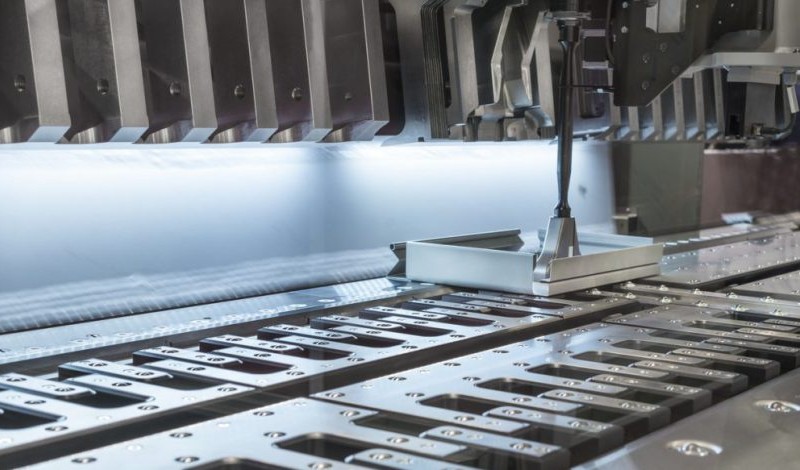Steel Marking Innovations: Elevating Manufacturing Processes for Superior Results
In the realm of making processes, metal stamping has actually long been a cornerstone method for creating a variety of precision components. With the relentless march of technological development, the landscape of metal marking is going through a substantial transformation.
Development of Steel Stamping Methods

Additionally, innovations in material science have actually resulted in the development of high-strength alloys that can currently be seamlessly marked into intricate forms, satisfying a wider series of industrial applications. The combination of robotics and artificial intelligence has actually additionally enhanced the marking procedure by enhancing speed and precision while lowering the threat of human error.

Influence of Advanced Materials
Have innovative materials changed steel stamping processes substantially in the manufacturing industry? The solution is an unquestionable yes (Metal Stamping). The combination of advanced products has reinvented steel stamping, enabling manufacturers to accomplish higher precision, raised efficiency, and enhanced item high quality. By using materials such as high-strength alloys, advanced compounds, and cutting-edge finishings, metal stamping procedures can currently produce components that are lighter, stronger, and extra durable than in the past.
These sophisticated materials provide superior mechanical properties, deterioration resistance, and thermal stability, permitting suppliers to satisfy the needs of contemporary industries such as aerospace, automotive, and electronics. In addition, making use of advanced products in metal marking has promoted the production of intricate geometries and detailed layouts that were formerly unattainable through typical techniques.
Furthermore, the application of innovative products has led to reduced material waste, lower production expenses, and much shorter lead times, making metal stamping procedures a lot more lasting and affordable. As modern technology remains to advance, the impact of innovative products on steel marking processes is expected to drive further innovation and boost the competition of manufacturers in the global market.
Automation in Metal Stamping
The evolution of steel marking procedures driven by the integration of innovative materials has actually set the stage for significant developments in automation within the production market. Automation in steel marking has transformed manufacturing procedures, improving efficiency, precision, and overall output high quality. Via the usage of robotics, sensors, and computer-controlled systems, jobs that were lengthy and when hands-on can now be implemented with unrivaled speed and precision.
Automation in steel stamping not just speeds up production rates however additionally makes certain consistency in the manufacturing process. By minimizing human intervention, the danger of mistakes is significantly decreased, resulting in higher degrees of product uniformity and dependability. Furthermore, automation makes it possible for producers to embark on intricate marking jobs that would be difficult or not practical to accomplish manually.
Furthermore, automation in metal stamping adds to a safer working atmosphere by reducing the need for workers to participate in repetitive or harmful jobs - Metal Stamping. This shift towards automation not just boosts performance but likewise leads the way for the future of production, where technology plays a central function in driving functional quality
Quality Assurance and Evaluation Solutions
With an emphasis on accuracy and integrity, quality assurance and examination systems play a vital duty in making sure item excellence in metal marking processes. These systems are my latest blog post developed to keep an eye on every phase of production, from product assessment to the end product, to ensure that all components meet the needed criteria. By carrying out advanced innovations such as optical evaluation systems, coordinate gauging makers (CMM), and automated evaluating devices, makers can spot also the tiniest inconsistencies in dimensions, surface area quality, and general integrity of stamped parts.

Sustainability Practices in Steel Stamping
Structure upon the foundation of precision and dependability established through quality assurance and inspection systems, the integration of sustainable techniques in steel stamping processes is increasingly becoming a focal point for makers seeking to minimize ecological effect and enhance resource application. Sustainability practices in steel marking include a series of initiatives targeted at lowering waste generation, power intake, and greenhouse gas discharges throughout the manufacturing check it out procedure.
One secret element of sustainability in metal marking is the fostering of environmentally friendly products and modern technologies that promote recyclability and waste reduction. By utilizing recycled products and implementing energy-efficient equipment, producers can decrease their carbon impact and add to a much more sustainable production cycle. Furthermore, optimizing manufacturing processes to minimize material waste and power usage not only benefits the atmosphere but additionally causes cost savings for services in the future.
Furthermore, the execution of lasting methods in metal marking can improve brand credibility and attract ecologically aware consumers. As sustainability remains to acquire importance in the production industry, incorporating environment-friendly campaigns right into steel marking processes is crucial for long-lasting success and competition on the market.
Verdict
To conclude, steel stamping strategies have substantially developed in time, incorporating advanced products and automation to boost manufacturing processes. Quality control and examination systems play a vital duty in making certain exceptional results, while sustainability techniques are progressively being implemented to reduce ecological effect. These developments in metal marking have actually reinvented the market, resulting in a lot more reliable and lasting manufacturing approaches for numerous sectors.
Steel marking, when a guidebook and labor-intensive process, has transformed into a highly automated and sophisticated method of shaping metal sheets right into various types and styles.Have sophisticated products changed steel stamping click now procedures dramatically in the production sector? By making use of products such as high-strength alloys, progressed compounds, and cutting-edge finishings, metal stamping processes can currently generate elements that are lighter, stronger, and a lot more long lasting than ever previously.
The development of metal stamping processes driven by the integration of advanced materials has set the phase for considerable improvements in automation within the manufacturing market.In verdict, steel stamping techniques have actually significantly evolved over time, including innovative materials and automation to improve making processes.